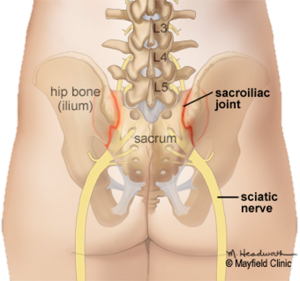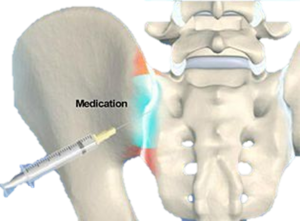Inflammation of the Sacroiliac joint causes pain in the lower back and buttocks, usually on one side only. SIJ dysfunction is a term which is commonly used when talking about sacroiliac injuries.
- Symptoms of Sacroiliac joint pain consist of pain at the bottom of the spine, usually located on one side.
- The pain can range from a dull ache to a sharp pain.
- Sacroiliac joint pain may radiate down the leg.
- Difficulty turning over in bed or putting on shoes & socks.
- There may be tenderness on palpating
What are the SI Joints
The Sacroiliac joints are located at the very bottom of the back, one either side of the spine and help make up the rear part of the pelvic girdle. They sit between the sacrum bone and the Ilia or hip bones. The function of the SI joints is to allow torsional or twisting movements when we move our legs. The legs act like long levers and without the sacroiliac joints and the pubic symphysis which allow these small movements, the pelvis would be at higher risk of a fracture.
Dysfunction refers to either hypo or hypermobility (low or high respectively). In other words, the joint can become ‘locked’ or be too mobile.
This can then lead to problems with surrounding structures such as ligaments (e.g. Iliolumbar ligament) and muscles, which means SIJ problems can cause a wide range of symptoms throughout the lower back and buttocks, or even the thigh or groin.

Causes
Causes of Sacroiliac joint pain can be split into four categories;
Traumatic injuries to the SIJ are caused when there is a sudden impact which ‘jolts’ the joint. A common example is landing on the buttocks. This kind of injury usually causes damage to the ligaments which support the joint.
Biomechanical – Pain due to biomechanical injuries will usually come on over a period of time and often with increased activity or a change in occupation/sport etc. The most common biomechanical problems include leg length discrepancy, overpronation, twisted pelvis and muscle imbalances
Hormonal changes – most notably during pregnancy can cause sacroiliac pain. In preparation for giving birth, the ligaments of the pelvis especially increase in laxity. Combining this with an increase in weight putting extra strain on the spine may lead to mechanical changes which can result in pain.
Inflammatory Joint Disease – Spondyloarthropathies are inflammatory conditions which affect the spine. These include Ankylosing Spondylitis which is the most common inflammatory condition to cause SI joint pain.
Treatment
Joint mobilisations
Mobilisations are techniques used by professionals such as physiotherapists, chiropractors, and osteopaths to help promote fluid movement at a joint.
Exercises
The aim of exercises for treating Sacroiliac joint pain is to correct and muscle imbalances. This is likely to include pilates exercises which may help strengthen the core muscles of the trunk.
Stretches
Stretching exercises for the muscles of the hip, particularly the hip abductors and gluteal muscles can help if done gently, however, too much stretching with a hypermobile joint can inflame the joint and increase pain.
Steroid Injection
Corticosteroid injection into the SIJ may be used if the above treatment fails

Contact Me
Let's chat!
Need more information? Send me an email or drop me a line. I don’t bite!
- Charlotte@rehabontheroad.co.uk
- 07971448719

